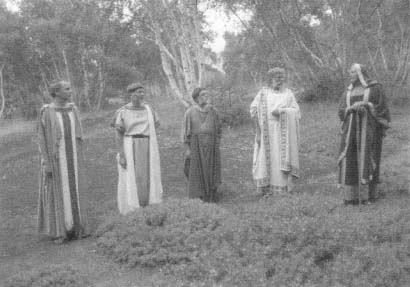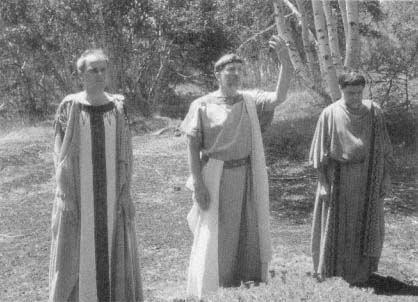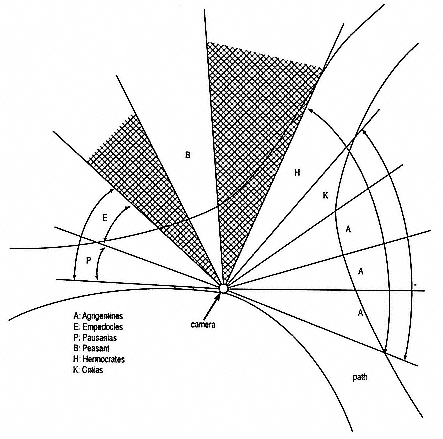The Paratactics of Cinematic Space
The refusal to choose also accepts the fragmentary nature of the Hölderlin text, both as a narrative and as language. Here we see in the narrative of the
film one of the signs of Hölderlin's modernism as Santner has described it in regard to the late poetry. The ideal narrative to which Hölderlin aspired was that of a spiral development, with a Hegelian progression from unity through alienation to a higher unity. As we have seen here, however, the fragmentary nature of Empedocles suspends the narrative before it can be resolved. In addition to this, Straub/Huillet cut off the narrative spiral in terms of the film as well. They delete the last scenes in which Pausanias, Delia, and Panthea converse about what may have happened to the hero. Instead, the film ends with the image of Mount Etna and the voice-over of Empedocles' last hymn to nature. Thus the contradictory tension present throughout the film is perpetuated: the absence of Empedocles, his ascent as a hero into the flames of oblivion, is contradicted by the verdant presence of nature, particularly in the form of the repeated long shot over the valleys toward Mount Etna.
Another way of putting it would be that the unity that is achieved at the conclusion of the narrative does not take place in the narrative at all but rather in language and image alone. The character of Empedocles is gone, and all that remains is Hölderlin's language and the documentary capability of the cinema. Rather than a conclusion, therefore, I argue that this is a suspension of the narrative. As such, it corresponds very closely to those "anxieties" Santner points out in Hölderlin's narratives, which point to his modern, if not post-modern, quality.
The primary function of the circular/spiral narrative (and perhaps, in a certain sense, of narrative as such ) was, for Hölderlin, the paradoxical one of guaranteeing a seamless continuity across spans of separations, gaps of space and time. The problematic that seems to loom in the background of Hölderlin's theoretical enterprise (a problematic that has become a postmodern preoccupation) is the structure of representation itself, the gap that emerges between signified and signifier in the exteriority of any expression. [. . .] The very structure of expression seems to involve a primary experience of alienation, rupture, difference. The circular/spiral narrative tells the story of this rupture and its redemption.[55]
In the poetry of Hölderlin, Santner finds the most exciting, modern quality precisely "where the energy of the language outstrips the narrative of redemption."[56] The breakdown of this narrative closure, what Santner prefers to call the "loosening of narrative vigilance," is described in his book on the basis of a number of seeming imperfections in Hölderlin's later poetry. Of interest to our examination of the Empedocles film are two areas, the separation of elements and poetic parataxis.
The separation of elements results in part from the anxious self-consciousness or exaggerated concentration on stages of the narrative progression or on images and states of mind in Hölderlin's work. For instance, although critics have seen in Hölderlin's narrative the idealist unification of opposites, "the
Hegelian identity that manages to comprehend alterity," Santner is uncomfortable with "this subordination of the strides of Hölderlin's verse to the cadences of spirit." For, he concludes, "The space between the strides seems, at times, infinite."[57]
The particular evidence of this interruption of the narrative impetus is found in parataxis, the quality that Adorno found to be the most modern in Hölderlin's poetry. Santner's definition of parataxis applies equally well to Straub/Huillet's film as to Hölderlin's poetry: "Paratactic composition will tend to juxtapose images, let them stand side by side, without subordinating them to any overarching narrative syntax."[58]
The effect of this is not necessarily "minimalist," however, to use a word often found in Straub/Huillet criticism. Instead, the tension created by the contradiction between paratactic composition and narrative expectation, as we have seen, produces powerful aesthetic effects, closely related to those of early cinema. Again, this contradiction is seen by Santner as part of Hölderlin's modernism: "Often troublesome in Hölderlin's 'paratactics' is our inability to decide which of the two forms we are confronted with: absence may begin to look like excess, abject silence may become the promise of infinite possibilities. But what is more, both absence as well as excess of signification may prove to be psychologically intolerable. Such a reading of Hölderlin places him squarely within current debates about the redemptive vs. repressive aspects of narrative."[59]
We will presently look at the connection between Hölderlin's parataxis and Straub/Huillet's composition, editing, and treatment of nature. But the issue of the narrative of redemption should first be examined more closely. The narrative in the Empedocles film is presented in the context of a rather strict separation of elements: each character or group of characters (who act with a common purpose) is photographed in rather long takes against a vivid and carefully composed (or rather, "selected") natural background. Very seldom are dialogue exchanges edited in a version of shot-countershot, and when this is done, only the camera angle (and perhaps the distance) is changed, not the camera position.
One example is illustrated in the figures on pages 194 and 195. The camera placement indicated is from the original screenplay sketch, while the arrangement of figures has been revised in the actual shooting.[60] The sequence is a dramatic interchange between three citizens, Critias, and Hermocrates, on the one hand, and Pausanias and Empedocles, on the other hand, when Empedocles is implored to return to Agrigento. The shots consist of the entire group of Agrigentines, including Critias and Hermocrates, two-shots of Pausanias and Empedocles, and close-ups of each of the imploring citizens, Critias, Hermocrates, and Empedocles. The narrative is indeed partly reflected in the editing: the delegation is heard to approach, and Pausanias looks offscreen to the left to see them. This anticipation is confirmed by the appearance of the

The citizens implore Empedocles to return to Agrigento: from left,
as citizen, Frederico Hecker, Peter Boom, Giorgio Baratta; William Berger as
Critias; Howard Vernon as Hermocrates. Courtesy New Yorker Films.
group, looking to the right at Empedocles and Hermocrates. At first, Hermocrates, the priest, speaks alone in a medium close-up. Then a longer shot reveals all five Agrigentines in a row, with Critias and Hermocrates farthest to the right, closest to Empedocles. There are close-ups of Empedocles and Hermocrates during a short interchange and close-ups of each citizen as well. As they reach the point of saying "we are reconciled," we see all the Agrigentines in a group again, this time in a four-shot minus the villainous priest Hermocrates. He remains invisible for the rest of the seen, "not reconciled" and "unforgiven." At this point the dramatic space is interrupted by the first of the two panoramic views across the foothills to Etna, while Empedocles addresses the gods once again.[61] After this, we again see the citizens, an exchange in close-up reconciling Critias and Empedocles, which ends the scene: Empedocles looks left in profile close-up; Critias turns from profile (looking at Empedocles) and exits to the left of the screen.
Clearly the narrative space, with the exception of the somewhat ambiguous view of Etna, is unified to an extent by the dialogue, the eye-line matches, and the single camera position, to the side and between the two parties. The compositional elements are separated, however; no master shot reveals the relative location of the two groups, and each shot is composed as resting in itself

The three citizens from the same camera position
but isolated by a change of lens. Courtesy New Yorker Films.
rather than implying any overlap of space. With the exception of the rather emotional reconciliation between Critias and Empedocles, the space between the two groups could be infinite, and no thought of motion from one to the other is suggested by the composition; quite the opposite.
The background of the compositions also separates them visually: the citizens are on a path with a group of birches behind them, and aside from the white verticals of these tree trunks, the background is a curtain of bright, yellowish green. Pausanias and Empedocles, by contrast, are standing at the base of an old pine tree where Empedocles had been resting. Juxtaposed with the lightness and nuance of the long shots of the Agrigentines, the shots of Empedocles and Pausanias have much more contrast, ranging from full black of the shadows under the pine to the white of Empedocles' hair.[62] The close-ups and extreme close-ups of Empedocles, especially at the end of the scene, intensify the "expressionist" quality of this composition as the light of sun and cloud shifts, producing sharply contrasting fields of color. The close-up lens turns the distant background into a bright wash of yellow-green and bright blue sky, while it shocks with the clarity of the black shadows, the dark brown pine branch, the rich green of the individual pine needles, the flesh tones of the face, and the blue of the costume and the white of his hair.

Camera position for Act II of The Death of Empedocles , based on
Straub's screenplay sketch. The arrangement was altered in
final shooting. Graphic: Andrew Reich.
The still, extreme long shot of Etna is a third element, which may bear a relation to this space if we assume it is seen by Empedocles as he speaks to the gods. But in color and composition, it, too, remains fundamentally "other."
The force of this scene arises not only from its paratactics but also from its drama and narrative, which is defeated by the isolation of Empedocles in his grandeur and of Etna in its remoteness. This duality may correspond to Santner's description of Hölderlin's narrative, contrasting it with the "epic" prescriptions of Schiller and Goethe, following the tradition of Homer. Their definition of "epic" does suggest a rather modern "separation of elements," where images succeed each other while remaining separate and without hierarchy. In Santner's words, "The deictic gesture of epic, the 'photographic'
quality of its comportment vis-à-vis the things of the world, is in turn mirrored in the relative independence of units in the text."[63]
But the difference between Hölderlin and the idealist tradition is the questioning of the overarching basis that previously provided security for such independence. Santner terms this "the quality, more than any other, which makes Hölderlin an early modern—the use of an epic style in the absence of 'epic space' and 'epic security,' the absence of a 'public square' that would encompass and give human and social meaning—a depth dimension—to concrete particulars."[64] After we consider once more the "infinite possibilities" suggested by the absence of "epic security" in the Empedocles film, we will consider how both this film and more significantly Antigone investigate the problem of the absence of a "public square" in contemporary culture.[65]
The result of using this "epic style" is a form of modernism that equalizes the importance of compositional elements to develop structures of interaction between them. Therefore, it is quite appropriate to think of Schoenberg's twelve-tone composition in regard to Straub/Huillet's Hölderlin films, as Santner does in writing of Hölderlin's parataxis.[66] Aside from the lack of hierarchical organization on the level of language, the various levels of narrative, history, and what Huillet would call "archaeology" also characterize Straub/Huillet's treatment of "film language." Here we are again in close proximity to the role of the poet in the context of Hölderlin: "No longer authorized to narrate the grand myth of redemption, he [the poet] must choose a more modest task: discovering relations, correspondences, constellations of meaning within the field of history—understood as a field of dispersed events rather than the plot of Heilsgeschichte —amid 'the millionfold hydra of the empirical world,' and, finally, within language itself."[67]
The first manifestation of this approach to meaning is the simplification and rendering equal of elements of composition that Straub/Huillet undertake. We have already noted that the shots are of long duration; each is a composition that is complete in itself, and there is no camera movement in the Empedocles film. In other words, it is a step in Straub/Huillet's return to some of the qualities of silent film. As noted above, also, the compositions gain individual weight as camera position does not alter: there is thus no redundancy in the space that they reveal, so all the information in a shot is significant and will not be supported or confirmed by another perspective. Ignoring the industry conventions regarding the consistency of light or sound is part of this as well, as Alain Philippon has written: "The absolute submission of the method to the reality of a landscape or a climate (if a cloud passes, the camera captures a noticeable variation in luminosity) arises from a vision of the world where everything counts, without hierarchy." As Straub/Huillet are fond of quoting Rosa Luxemburg in this context, "The fate of an insect is not less important than the fate of the revolution."[68] Other aspects of the equal significance of the elements include the way that all the characters are photographed and the recording of
their speeches. Regardless of how insignificant a character's role might be, that person is photographed with as much compositional clarity and respect as any other. The duration of their speeches or their relative position may be conveyed through editing, but the "portraits" of them are all of equal dignity. And the landscape, too, is a character, or a drama. Describing her work on the cinematography for Too Early, Too Late , Caroline Champetier has written, "Certain shots are the interpretation of a movement of the sky on the earth; while filming, those were instants of true joy."[69]